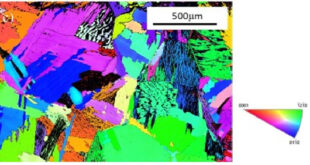Significance
The Siemens method is widely used to produce polycrystalline silicon used in numerous applications such as fabricating solar and electronic devices. It is an energy-intensive process comprising a conventional Siemens reactor that facilitates the production of silicon rods. The low energy efficiency of the reactor can be partly attributed to the dissipation of a large amount of heat together with the exhaust gases. Consequently, the increase in the dimension of silicon rods limits the diameter of rod deposition due to the increased temperature of the rod core to aid the thermal decomposition of trichlorosilane. Notably, the manufacturing process ceases when the rod diameter reaches 140 mm, allowing collection of the produced silicon rods to protect them from melting, considering that their melting point is the same as that of polysilicon.
The high thermal energy loss of 70 – 85% of the total energy associated with the Siemens reactors has attracted considerable research attention. Many strategies have been proposed to increase the thermal energy efficiency of chemical vapor deposition (CVD) reactors. They include using a thin gold layer on one or more components within the reaction chamber, using reflective silver to plate the inner surface of the cooler, enhancing the reactor wall properties, increasing the reactor capacity, and improving the overall energy efficiency of the production processes involving Siemens CVD reactors. All these strategies have made significant contributions to enhancing the energy efficiency of Siemens reactors and polysilicon manufacturing. Unfortunately, using silver or gold to coat the internal walls of the reactors is inconvenient, difficult, and extremely expensive. In addition, the harsh reaction environment and process deposit precipitation on the coated wall make it difficult to maintain the reactivity of gold and silver.
To address the aforementioned challenges, researchers from Kunming University: Professor Zhifeng Nie, Ms. Yajun Wang, Ms. Chen Wang, Mr. Qijun Guo in collaboration with Dr. Yanqing Hou from Kunming University of Science and Technology, Professor Palghat Ramachandran from Washington University in St. Louis and Professor Gang Xie from Kunming Metallurgical Research Institute developed a novel optimization design approach based on quartz ceramic lining for improving the energy efficiency of Siemens reactors. A mathematical model was proposed to analyze the energy efficiency of a 24-rod Siemens reactor. The effects of heat transfer and geometrical parameters on the productivity and efficiency of the Siemens reactors were examined. The feasibility of the model was validated by comparing the results to the industrial and experimental data. Their research work is currently published in the journal, Applied Thermal Engineering.
Results showed that the ceramic lining improved the productivity and energy efficiency of the Siemens reactors, enabling efficient production of the polysilicon. Like thermal insulators, ceramic lining with remarkably low thermal conductivity and considerable thickness prevented heat transfer across the ceramic lining to significantly contribute to the overall energy conservation and efficiency. Despite increasing emissivity due to precipitate deposits on the lining, its impact on the total radiated energy loss was relatively low. Overall, the energy consumption of a 24-rod Siemens reactor was reduced from 55 to 36 kWh per kg polysilicon.
In a nutshell, a computational fluid dynamics (CFD) model considering the design and operating parameters was developed to enhance the productivity and energy efficiency of polysilicon manufacturing processes by increasing the performance of the existing Siemens reactors. The quartz ceramic lining reduced the total electric current to smoothen the distribution of the thermal stress and attain a larger rod deposition diameter. Based on the energy efficiency analysis, the proposed framework proved effective for improving the productivity and energy efficiency of Siemens reactors that are currently used in different industrial processes. In a statement to Advances in Engineering, Professor Zhifeng Nie, first author said, polycrystalline silicon is a critical raw material in the solar and electronics industries, and it is important to seek higher efficiency in the production thereof with the Siemens technique. Overall, he believed that this research makes an important contribution to the body of research on such technology, adding value to the field of energy analysis, energy modelling and prediction at large. He also noted that the study would facilitate the design of high-performance reactors for efficient production of polycrystalline silicon.
Reference
Nie, Z., Wang, Y., Wang, C., Guo, Q., Hou, Y., Ramachandran, P., & Xie, G. (2021). Mathematical model and energy efficiency analysis of Siemens reactor with a quartz ceramic lining. Applied Thermal Engineering, 199, 117522.
 Advances in Engineering Advances in Engineering features breaking research judged by Advances in Engineering advisory team to be of key importance in the Engineering field. Papers are selected from over 10,000 published each week from most peer reviewed journals.
Advances in Engineering Advances in Engineering features breaking research judged by Advances in Engineering advisory team to be of key importance in the Engineering field. Papers are selected from over 10,000 published each week from most peer reviewed journals.

